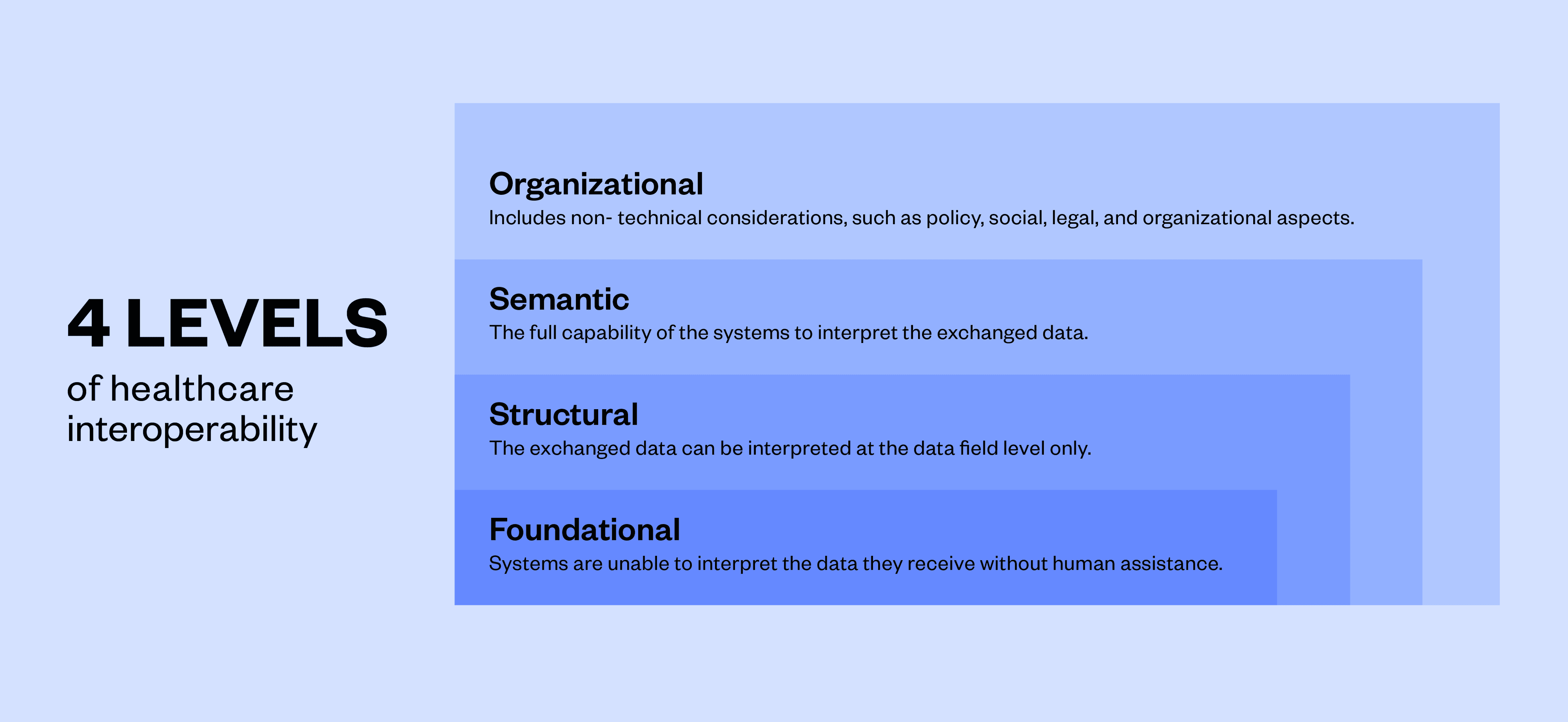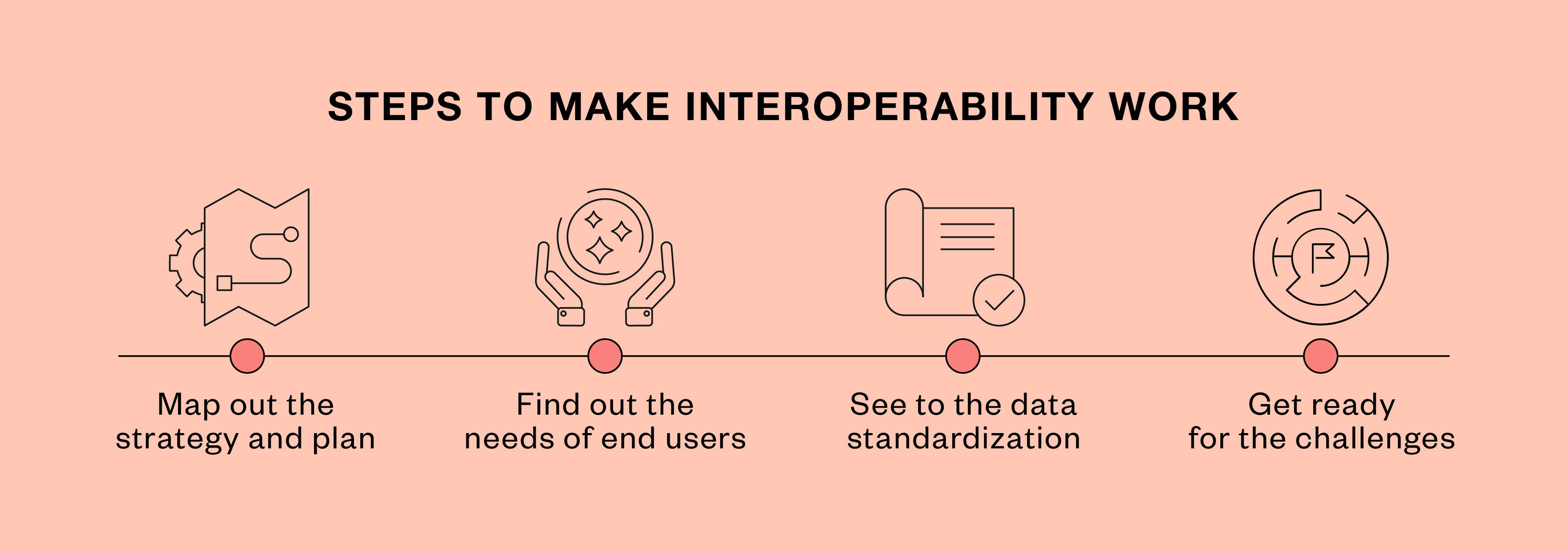
Interoperability in healthcare: A comprehensive guide

Nearly one-third of hospitals and health systems label their interoperability efforts as insufficient, as stated in a recent survey by the Center for Connected Medicine (CCM).
Basically, it means that they're failing to provide high-quality patient care, prevent medical errors, curtail growing healthcare costs, and improve hospital safety. Since following the trial and error approach is unacceptable for a healthcare industry, it's crucial to focus on interoperability as one of the solutions to these healthcare challenges.
If you're wondering what healthcare interoperability is, what benefits it brings, and why it's important, this guide is for you.
What is interoperability in healthcare?
As stated by the Healthcare Information and Management Systems Society (HIMSS), there are four levels of healthcare interoperability.

1. Foundational interoperability is the capability of the one system or software application to exchange healthcare data with another system, with no possibility to interpret the data without human assistance. For example, sending a PDF file with patient data via a patient portal implies that the document's recipient will have to manually transfer the data from the file into the electronic medical record (EMR) system.
2. Structural interoperability implies that the exchanged data is stored in the recipient system, and there's a possibility of its interpretation at the data field level. The exchanged data has a particular structure and should keep it after the transmission. This is the case when data from activity trackers or medical devices such as glucometers are sent to a patient portal.
3. Semantic interoperability presumes that the systems are fully capable of interpreting the exchanged data, which helps physicians make effective, data-driven decisions. At this level, Health Information Exchange (HIE) is possible, which allows connected healthcare providers to ensure the utmost patient care.
4. Organizational interoperability is a concept introduced in 2019 that includes non-technical considerations worth following to provide top-level interoperability. These considerations embrace policy, social, legal, and organizational aspects, allowing for easy and efficient exchange of healthcare data between healthcare institutions and individuals.
Benefits of interoperability in healthcare
Building interoperable health IT infrastructure has become a top priority for many healthcare providers due to the array of benefits it brings to them and their patients.
1. Effective prevention of medical errors
Being the third leading cause of death in the United States, medical errors are a grave problem that can be mitigated with a set of proactive measures. One of them is timely and streamlined exchange of the patient's data among healthcare organizations, as well as outside providers such as insurance companies. Obtaining complete and accurate data about a patient's allergies, previous conditions, and medicines aids in averting fatal errors and making safe decisions regarding treatment.
2. Secured patient healthcare data
According to Verizon's Data Breach Investigations Report, healthcare organizations accounted for 15% of the data breaches that occurred in 2019. That's why safeguarding patients' sensitive info is a key objective of every healthcare provider. Luckily, it can be enhanced with interoperability. If the healthcare systems aren't connected, tracking user access to an EHR and managing their access rights becomes a tall order. Conversely, when the patient's information is entered into connected, interoperable systems, it's easy to spot who can gain access to this sensitive info and impose rules and restrictions regarding the possibilities of data manipulations, to avert a data breach.
3. Better patient experience
Typically, patients fill out endless forms, scrape through their insurance policies, and tell about their symptoms repeatedly when seeking medical assistance. Giving healthcare organizations direct access to the needed patient info from external sources through interoperability ensures a seamless patient experience with little to no administrative activities or delays.
4. Reduced healthcare expenses
According to the West Health Institute (WHI), interoperability in healthcare could save more than $30 billion per year for the U.S. healthcare system. It stems from a notable productivity increase of the medical staff, unburdened from repetitive manual entry and updating of patients' data. Interoperability also eliminates the inefficiencies of working with disparate systems that aren't sharing critical data, thus creating threats to patients' health and posing a financial burden to healthcare organizations.
Achieving interoperability: The Vention way
Our healthcare experts suggest taking the following steps to make interoperability work for your healthcare organization.

#1 Map out the strategy and plan
As a strategy lays the groundwork for your interoperability success, it should contain critical aspects such as your vision, objectives, desired future state, an implementation methodology, and technologies to be used in the project. It's also important to embrace interoperability standards: FHIR, USCDI, and LOINC shouldn't be buzzwords, but things to adhere to for a seamless and secure data exchange. The implementation plan, in its turn, should include a timeline with implementation stages, resources, responsibilities, and risks. Another critical thing is to involve key stakeholders as early as possible to ensure their support for the project.
#2 Find out the needs of end users
It's a prior importance to survey the end users (in this case, clinicians) to find out their needs and take them into account. Otherwise, the newly implemented solution may only pose more obstacles to the personnel, instead of solving their problems. For example, if the solution requires scraping through the piles of poorly structured patient data, it'll only lead to lower productivity of the medical staff and hampered decision-making. To prevent that and deliver a solution convenient to end users, maintaining an ongoing collaboration of the CIOs with the medical staff is a must.
#3 See to the data standardization
Achieving high-level interoperability is impossible without managing different types of data formats and interfaces efficiently. For instance, claims data is in the X12 format, while lab data is in the HL7 format. EHR data may be present in HL7, CCDA, or FHIR formats.
#4 Get ready for the challenges
Here are the typical issues you're most likely to encounter while working toward greater interoperability.
- Huge amount of disparate data: The huge amount of data now comes from smart medical devices and wearables, in-hospital patients, patients with chronic diseases, etc. This results in piles of non-structured data, which is hard to manage for a healthcare organization. To normalize and bridge data coming from various sources with healthcare organizations, the latter may turn to IT healthcare companies that provide technology solutions for the goal.
- Variety of standards: As mentioned above, there are various electronic exchange standards in healthcare, each catering for specific needs of healthcare institutions. "Standards are agreed-upon methods for connecting systems together. They may relate to security, data transport, data format or structure, or the meanings of terms," according to the Office of the National Coordinator (ONC). The lack of a common standard for managing and sharing patient data leads to data inaccuracies, exchange delays, and other hurdles to reaching healthcare interoperability.
- Inconsistent patient identification: Due to manifold patients' identifiers (e.g., name, date of birth, and social security number) stored differently in healthcare systems, and patients' own mistakes in the medical forms, problems with patient identification are frequent. As a result, a patient that visits different doctors or different hospitals can get the wrong treatment due to being mismatched to his or her record. Having a national patient identifier (NPI), a unique number assigned to a patient for use across the healthcare system, would curb the issue. Alas, the development of the NPI isn't yet underway, so patient mismatching continues to occur.
- Insurance providers are reluctant to cooperate: According to the new interoperability rule issued by the Centers for Medicare and Medicaid Services (CMS), patients can get their health information from interoperable forms. It means that all patients' information will be shared among healthcare providers. Insurers are also to contribute to the process of making patient data interoperability by giving access to full claims history to patients as well as healthcare organizations. However, insurance providers are still being slow and reluctant in cooperating with healthcare organizations and sometimes refuse to disclose this information.
Now, it's your move
A 20-year forecast by Deloitte states that with interoperable data and AI, we'll be preventing and spotting early-stage issues rather than dealing with grave illnesses by 2040. To make it happen, it's vital to go for interoperability today and see it as a necessity rather than an option. Back in 2020, the lack of interoperability will not only hamper your patient experience, decision-making, and cost management but also be a surefire way to fail your AI and robotic automation projects, should you decide to embrace these red-hot healthcare trends. So, it's high time to work toward greater interoperability, which puts your business light-years ahead of its rivals.





